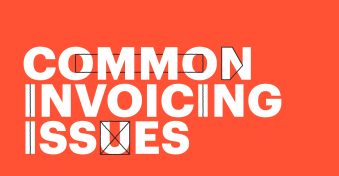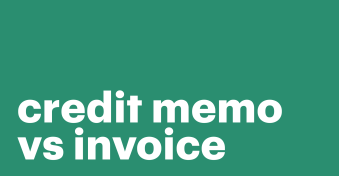Need business invoice examples? Maintaining a consistent cash flow is crucial, and invoicing plays a key role in achieving it.
Clients very rarely settle their balance without receiving a business invoice, as it serves essential purposes such as recordkeeping, payment reminders, due date tracking, and accounting.
Writing a business invoice is beneficial to both sides, ensuring transparency and efficiency in financial transactions.
So, to help you navigate this process, this guide is here to provide you with business invoice examples that can serve as templates.
Key takeaways
- There are various types of business invoices out there, and the one you send to a client depends on the type of project.
- All invoices for business should include: invoice number, date, the word ‘invoice’, your contact information, client name and address, payment terms, itemized list with unit price, total amount, company branding.
- Samples of business invoices and templates to inspire you.
- There are many platforms you can use to create your own business invoice, but using a business invoice template is by far the best option due to the benefits it provides.
- PandaDoc’s vast template library makes creating the perfect business invoice easy.
Types of business invoicing
The type of invoice you send to a client can differ considerably depending on the kind of projects you undertake, how you price these projects, the agreement you have with the client, etc.
Let’s take a look at the most popular types of invoices commonly used by small businesses, freelancers, and enterprises.
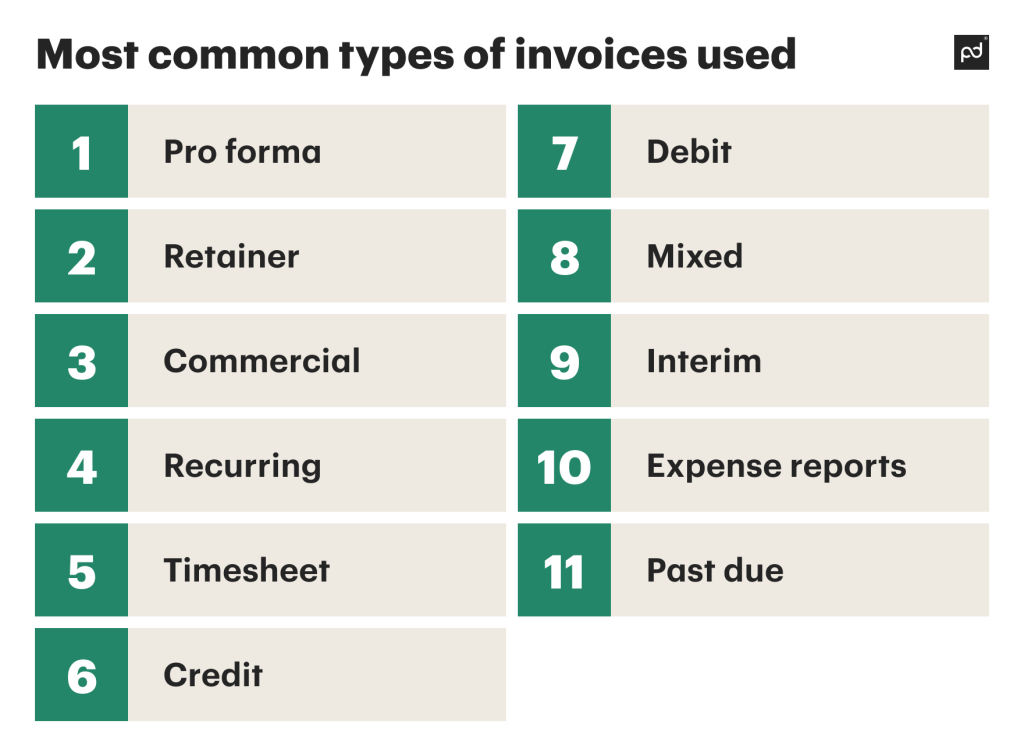
1. Pro forma invoice
A pro forma invoice is a basic invoice that’s created before the delivery of the product/service so that the client has an estimate of how much that product/service is going to cost.
2. Retainer invoice
Retainer invoices are made to get advance payment(s).
For example, if you’re working on a large project and need cash to get started, you can issue a retainer invoice to get some advance amount (this amount will be deducted from the subtotal).
3. Commercial invoice
A commercial invoice is an example of an invoice often made for international payments.
This invoice requests payment for a transaction that’s already been undertaken by the seller (i.e., the seller has already delivered the product/service).
4. Recurring invoice
Recurring business invoices are made for projects where payments are made continually, usually at regular intervals.
For example, if you take on fixed projects for a client every month, that’s when you create recurring invoices.
If you’re already using PandaDoc, it should be easy to set up recurring invoicing using this step-by-step guide.
5. Timesheet invoice
Timesheet invoices account for everything by the hour.
For example, if a lawyer works on a project for 10 hours at the standard rate of $100/hour, they will issue a timesheet invoice requesting payment of $1,000.
6. Credit invoice
This invoice for business is also known as a credit memo or a credit note.
The credit invoice accounts for any amount to be credited to the client.
For example, if there was an error in the previous month’s invoice and you added an additional $100 to the amount, the exact amount will be deducted from this invoice.
7. Debit invoice
Also known as a debit memo or a debit note, the debit invoice is the opposite of a credit invoice — that’s to say, instead of deducting the amount from your invoice, you’ll add the amount to it (e.g., if you made an error in the previous month’s invoice and neglected to charge $100 that was owed, you’ll add that amount to this invoice’s subtotal).
8. Mixed invoice
Mixed invoices have a combination of credit and debit amounts. These invoices are not usually issued but are still relevant to know about.
9. Interim invoice
If you’ve taken on a project that will likely last multiple months, an interim invoice might be necessary because it’ll help you get paid based on project milestones.
10. Expense reports
Expense reports form a collection of expenses that an employee or a contractor has to be reimbursed for by a business owner.
11. Past due invoice
If your client does not process your invoice by the agreed-upon due date, you’ll likely be sending a past-due invoice, which may or may not contain late fees and interest charges.
Alternatively, it may also be possible that the client is running into some invoice issues because of an error on your end.
Learn more about invoicing mistakes here and how you can avoid them.
What should a business invoice format include?
While there’s no hard and fast rule as to what an invoice should look like, there are a few elements even the most basic invoices should have.
Let’s look at the nitty-gritty details that need to be on a business invoice.
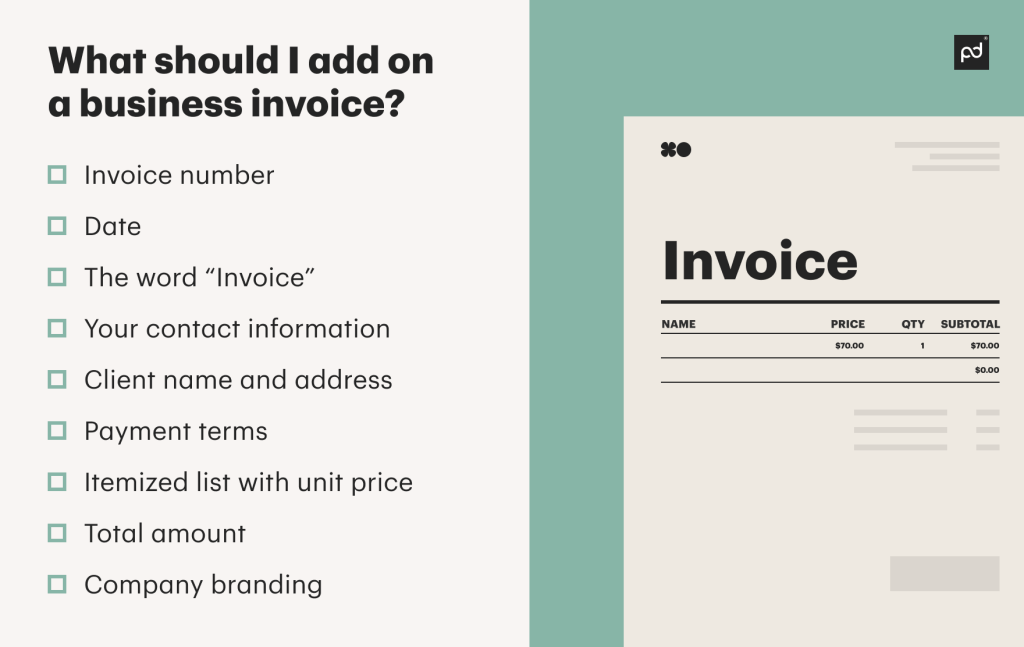
1. Invoice number
Often placed at the top, an invoice number is set in place to act as a reference number for taxes, bookkeeping, etc.
2. Date
The date of the invoice is also put at the very top — this is done so that you can keep track of when the invoice was sent (this helps when it comes to payment terms such as Net-X days and late fees).
3. The word “invoice”
Adding the word helps indicate that the document you’re sending is an invoice, not a bill.
4. Your contact information
This helps your clients (and their accounting department) understand which vendor has sent the invoice and how to get in touch with them in case any questions and concerns arise.
Adding contact information also has other uses, such as your clients being able to send physical payments and knowing which address to use for tax forms.
5. Client name and address
When you create multiple invoices during a month, adding a client name and address will help you track which invoice belongs to which client.
6. Payment terms
To ensure that everything is streamlined and your client’s accounts payable department knows when and how to make the payment, it’s good practice to write payment terms, such as which online payment mode you prefer, the due date to pay, late fee stipulations (if any), and other similar details.
7. Itemized list with unit price
An itemized list needs to be added so that both parties know what products/projects they’re being charged for.
Your itemized list can be filled with product names, product types, price of each item, quantity, etc.
8. Total amount
The total amount needs to be below the itemized list (this total amount should include taxes, freight charges, discounts, convenience or other associated fees, etc., as well as the subtotal price of all products and services).
9. Company branding
To give your invoices a professional look, it’s considered good practice to add company branding, such as your logo, colors, fonts, company name, etc.
You can easily do this with invoicing software.
For example, PandaDoc lets users change their company logo, button colors, text, email subject line, email footer, themes, and more when editing the invoicing template.
You can add optional stuff to your invoices, such as interactive media or a nice message indicating you enjoyed doing business with the client.
If you’re second-guessing what details should go where in an invoice, you can use PandaDoc invoice templates to guide you.
Sample invoices to inspire you
Now for examples of invoices!
Let’s get to the meatier bits and check out a few samples of invoice templates that can inspire your future invoice formats and designs.
1. Basic invoice
A basic invoice is one of the most commonly referred-to templates because it works across the board.
A sample of a basic invoice template looks something like this, and it includes the important details like billing address, payment terms, itemized list, date, invoice number, etc.
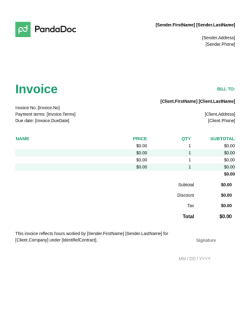
Blank Invoice Template
Used 5114 times
Quickly update this free blank invoice template to reflect your business and what service or product you're providing.
Use this template2. Sales invoice
A sales invoice will usually indicate the sale of a product or service undertaken for a client.
These invoices for business will list prices with classifications like product name, individual item price of each product, quantities, and product description (which can include details such as the make or model number and year made).
You can even add a comment or two to remind clients which project the invoice is associated with.
Here’s an example of what a sales invoice looks like:
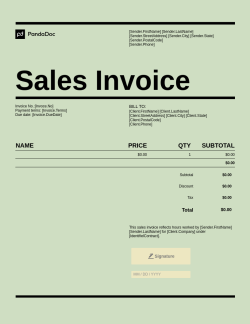
Sales Invoice Template
Used 5437 times
Use this professional sales invoice template as a sample on which to base all the sales invoicing of your product or service.
Use this templateExplore all PandaDoc integrations here to learn how the solution adapts to your existing tech stack.
3. Service invoice
A service invoice is specifically created when a contractor or business provides their labor or advice for a project.
Such projects are either priced by the hour or use individual project prices (e.g., if you’re a photographer, you can choose to price wedding packages and maternity packages differently), or are pricing based on industry standards (e.g., some writers and journalists choose to charge clients based on a fixed amount per-word).
Here’s an example of what a service invoice could look like:
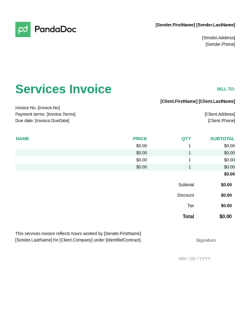
Service Invoice Template
Used 5045 times
Use this free Service Invoice Template as a sleek way to invoice online and offline.
Use this templateYou don’t need to stick to a one-page invoice, either.
For example, PandaDoc has a painting invoice template that’s seven pages long and has details like:
- Billing address
- Materials and description (as well as an itemized list of all materials used)
- Service charges (itemized list here too)
- Project schedule (individual day schedules are created)
- Terms and conditions of the agreement
- A personalized message
- Signatures of both parties
You can get the template here.
4. Tax invoice
If you’re wondering how to go about creating invoices that have the dreaded word “tax” in them and where and when you should add taxes to the docs you send out, you can refer to these invoices.
Tax invoice

Tax Invoice Template
Used 4962 times
This is a free example of a standard tax invoice template that you can edit for the purposes of charging VAT or sales tax.
Use this templateVAT invoice

VAT Invoice Template
Used 5029 times
You can create invoices based on your design layouts, set recurring invoices, send automated payment reminders and late fees with this VAT Invoice template.
Use this template5. Commercial invoice
Commercial invoices may often go the extra mile and include details like system codes, country of origin, and declaration forms, which a standard invoice may not have (or need).
Here’s an example of a commercial invoice you can refer to.
(Keep in mind the product you ship may require additional details; if so, use this sample as a guide, but check your customs requirements before creating a commercial invoice).

Commercial Invoice Template
Used 4979 times
Use this free sample of a commercial invoice template to process any trans-border shipments. You can use this along with our tax invoice template to process the different VAT or sales tax.
Use this template6. Pro Forma invoice
A pro forma invoice, aside from containing basic details like invoice number and date, should also have other mentions such as shipping and delivery information as well as remittance details.
You can also swap out your itemized list for a narrative which can be something like “Sales of X car, of Y model, launch year Z, priced at [insert amount].”
For reference, here’s a pro forma invoice template you can check here.
7. Freelance invoice
With freelance invoices, especially if you belong to the creative field, you have the chance to inject some creativity into your invoices.
For example, one way to make your freelance invoice stand out is to match it with the branding, colors, and fonts that went into your freelance proposal.
That’s just one way to make your artistry shine! You can also take inspiration from this freelance invoice (it’s like a standard invoice, except this, too, is more creative).

Freelance Invoice Template
Used 5228 times
Are you a freelancer? This free Freelancer Invoice Template was designed to help you get paid faster for the work you have been contracted to do. Customize it to your liking; add a cover page or images to identify your brand.
Use this template8. Rental invoice
Rental invoices can be used for rental agreements, as well as homestays (such as those delivered by Airbnb).
Here’s an example of how a rental invoice should look like (completed with details like billing address, payment terms, due dates, taxes, and more):

Rental Invoice Template
Used 4917 times
You as the landlord, landlady or property manager can use this free rental invoice template to bill your tenants.
Use this templateWhere to design a professional business invoice
Now that we’ve covered the broad strokes and reviewed invoice samples (aka, professional invoice examples), let’s deal with some important questions.
First off, where does one go to create a professional invoice?
What types of invoice generators are other small business owners using? How can I create a custom invoice?
Well, we’re covering how and where to create custom invoices. Let’s get right to it!
1. Microsoft Word
While some may think that the golden era of Microsoft has come and gone, there’s still a lot of use you can get out of Excel and Word.
Excel, for one, is great with calculations (so you do the calculations to get the subtotal of all your line items and quantities with it), and you can use Word to create the invoice itself.
Alternatively, you can use PandaDoc’s integration with Word to combine the best part of both solutions to create an invoice (e.g., if you have a readymade invoice template on Word, you can upload it on the PandaDoc editor and make the necessary changes).
If you wish to directly create an invoice on Word itself, you can go on the app and check out the multiple templates near the header.
From those, simply select the invoice template that suits your requirements and begin working.
2. Google Docs
Just like Microsoft Word, Google Docs has a template library as well. Go on the app and click on “template gallery.”
Once there, you can use the quote templates and fashion them into a business invoice, or you can start from a blank document.
3. Invoicing software
Another great way to send business invoices to others is to use invoicing software. While many are available in the market, the only one we can vouch for is PandaDoc.
Not only does our solution have a library of business invoice templates you can use, but you can also add custom branding, rich media, signatures, etc., and track your invoices immediately.
But aside from the basics, here’s what differentiates us from our competitors:
- When you purchase our product, you don’t only get a business invoicing solution. Rather, you get an all-in-one document management platform that can manage proposals, quotes, contracts, e-signatures, forms, payments, proposals, etc. — and invoices.
- Our solution is adaptable for small and large businesses, and we price our service based on per user, so you only pay for the team members that use PandaDoc.
- We can also customize based on your needs. For example, PandaDoc can be personalized based on industry-specific or team-specific requirements.
- We also offer affordable pricing. For example, Qwilr’s pricing starts at $35/user/month, and Proposify’s starts at $49/user/month. In comparison, we offer more features, and our pricing begins at $19/user/month. Also, you get a free eSign account, too, if you don’t wish to opt for the premium version of PandaDoc.
Here’s what our customers have to say about us on TrustPilot:
Another testimonial:
4. Payment platforms
Certain payment platforms, such as Payoneer, Wise, and PayPal, will allow you to create business invoices from the platform itself.
15 benefits of using a great business invoice template
Still need to be convinced of the advantages of using a business invoice template?
Take a look at 15 benefits that PandaDoc templates can offer.
- Professionalism: A well-designed invoice template enhances the professional image of your business, leaving a positive impression on clients.
- Time efficiency: Templates streamline the invoicing process, saving time by providing a structured format that can be easily customized for each transaction.
- Consistency: Consistent template use ensures uniformity in your branding and communication, presenting a cohesive and polished image to clients.
- Accuracy: Pre-designed templates help avoid errors by including predefined fields and calculations, reducing the risk of mistakes in invoicing details.
- Branding: Customizable templates allow you to incorporate your company logo, colors, and branding elements, reinforcing brand identity in client interactions.
- Organization: Templates often include sections for itemized services, payment terms, and contact details, aiding in clear communication and record-keeping.
- Prompt payments: Clear and professional invoices, facilitated by templates, contribute to a positive client experience and may lead to faster and more reliable payments.
- Legal compliance: Templates can include essential legal elements, ensuring that your invoices meet regulatory requirements and protect your business interests.
- Effortless customization: With editable fields, a good template allows you to tailor invoices to specific clients or projects while maintaining a standardized structure.
- Accessibility: Digital templates can be easily stored, accessed, and shared electronically, providing convenience and accessibility from various devices.
- Financial tracking: Templates often include sections for tracking invoice status, making it easier to monitor outstanding payments and overall financial health.
- Client communication: A clear and well-organized invoice, facilitated by a template, helps in effective communication with clients regarding the details of the transaction.
- Efficient record-keeping: Using templates ensures that all necessary information is consistently recorded, aiding in efficient bookkeeping and financial record-keeping.
- Flexibility: Customizable templates offer flexibility, allowing you to adapt to different industries, types of services, or specific client preferences.
- Cost-effective: Using templates reduces the need for manual invoicing efforts, contributing to cost savings in time and resources for the business.
Create the business invoice of your dreams with PandaDoc templates
And so ends our collection of business invoice examples! For additional free invoice templates or other templates, check out the PandaDoc library for inspiration.
But, if you’re interested in exploring more of PandaDoc’s capabilities, take advantage of our 14-day free trial or arrange a call with our representatives to discover the full range of PandaDoc’s features.
Disclaimer
PandaDoc is not a law firm, or a substitute for an attorney or law firm. This page is not intended to and does not provide legal advice. Should you have legal questions on the validity of e-signatures or digital signatures and the enforceability thereof, please consult with an attorney or law firm. Use of PandaDocs services are governed by our Terms of Use and Privacy Policy.
Originally published April 27, 2023, updated July 16, 2024
